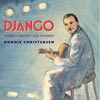The story of Django Reinhardt is a natural for younger audiences—unlike
so many other jazz musicians whose troubled lives and complex music have
become the stuff of picture books. In spare, simple, rhythmic verses,
Christensen tells the remarkable story of a young Gypsy boy, born in
Belgium in 1910, who was surrounded by music as a child, learning violin
from his father and later moving on to guitar. After his father
abandoned him, young Django found his way to Paris, where he played on
street corners, earning praise (“Gypsy Genius!”) and attracting
attention. Soon he was headlining in clubs, but all seemed lost when he
was burned in a fire, damaging his left hand so severely that playing
the guitar seemed out of the question. But Django developed a way to
work around his disability, and his self-made technique for playing
chords proved perfect for the syncopated jazz style. Christensen
supports the inspirational story with rich, vibrant paintings that
capture the texture and tone of the landscapes in Django’s life: burnt
oranges and various shades of brown bring the Gypsy campfires to vivid
life, while bright blues shimmering under the sharp yellows of stage
footlights depict the electricity of the guitarist in performance. The
art steals the show here, but the text works fine, too, describing the
essence of Django’s story without overwhelming middle-graders with too
much detail. Grades 3-6
 Default Manufacturer
Bonnie Christensen - Django: World's Greatest Jazz Guitarist (Hardcover)
Media > Books > Non-Fiction > Music Books
bonnie-christensen-django-greatest
1007
15.00
DjangoBooks.com
https://www.djangobooks.com/Item/bonnie-christensen-django-greatest
Default Manufacturer
Bonnie Christensen - Django: World's Greatest Jazz Guitarist (Hardcover)
Media > Books > Non-Fiction > Music Books
bonnie-christensen-django-greatest
1007
15.00
DjangoBooks.com
https://www.djangobooks.com/Item/bonnie-christensen-django-greatest










